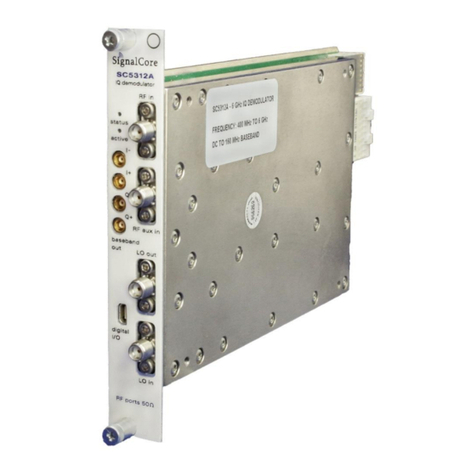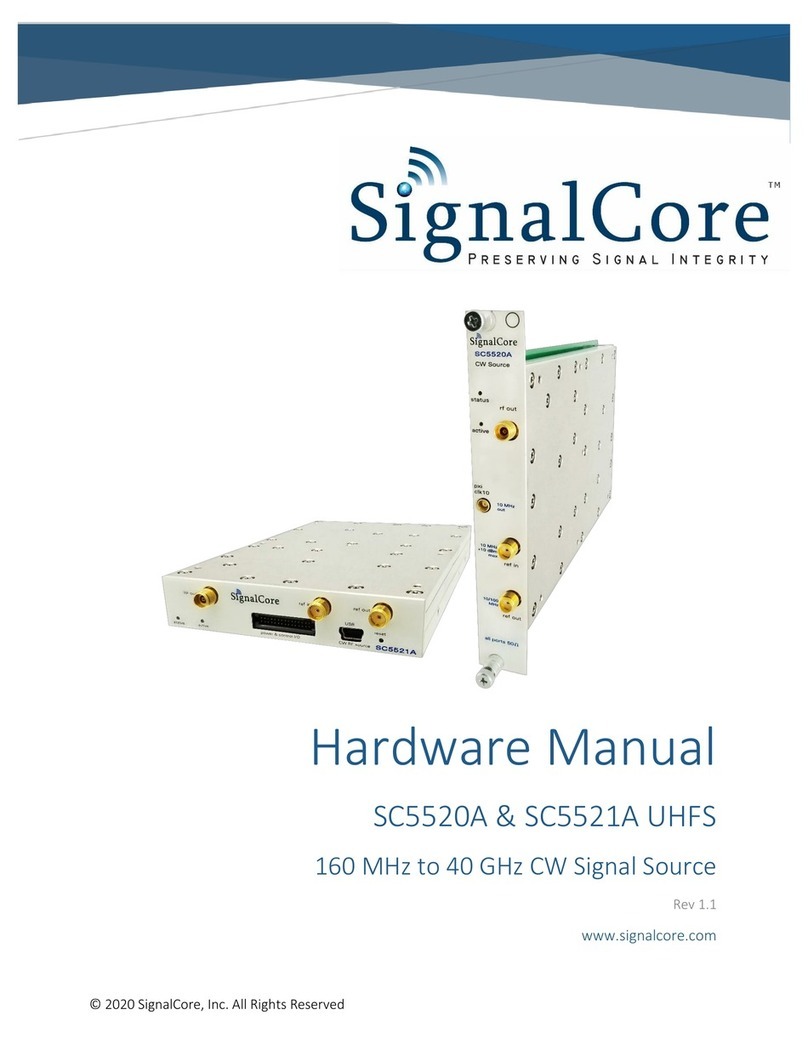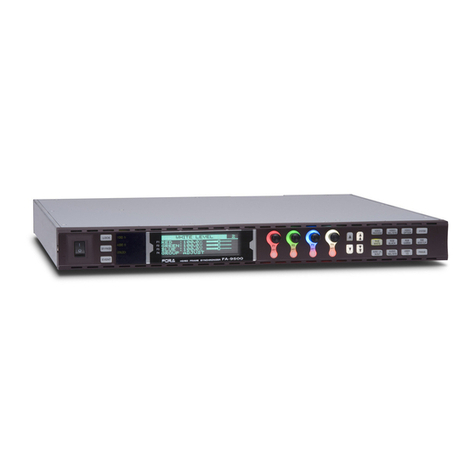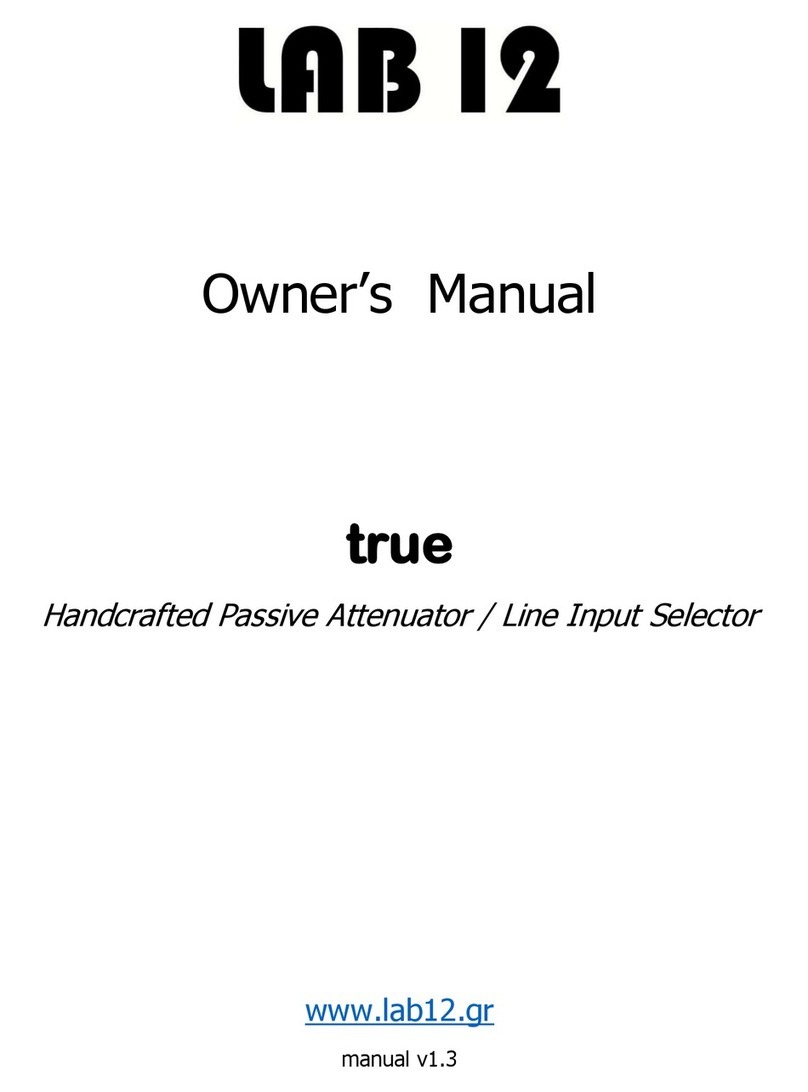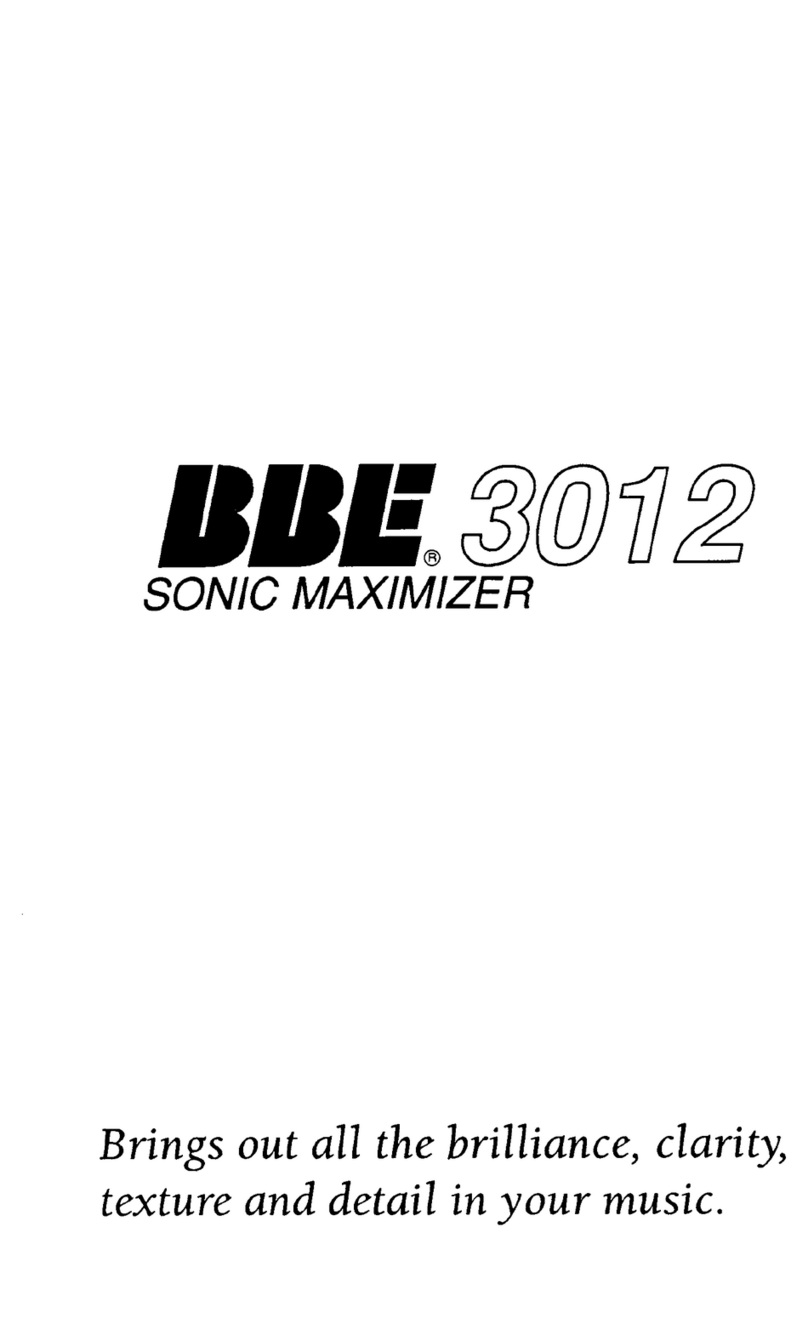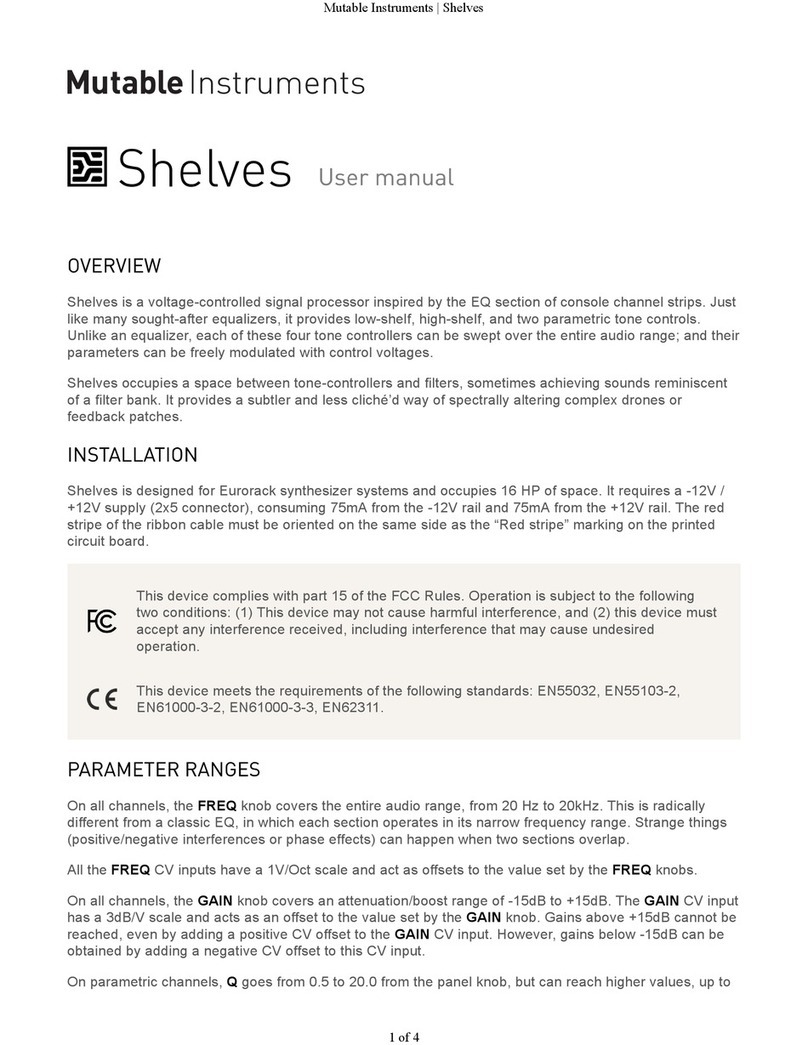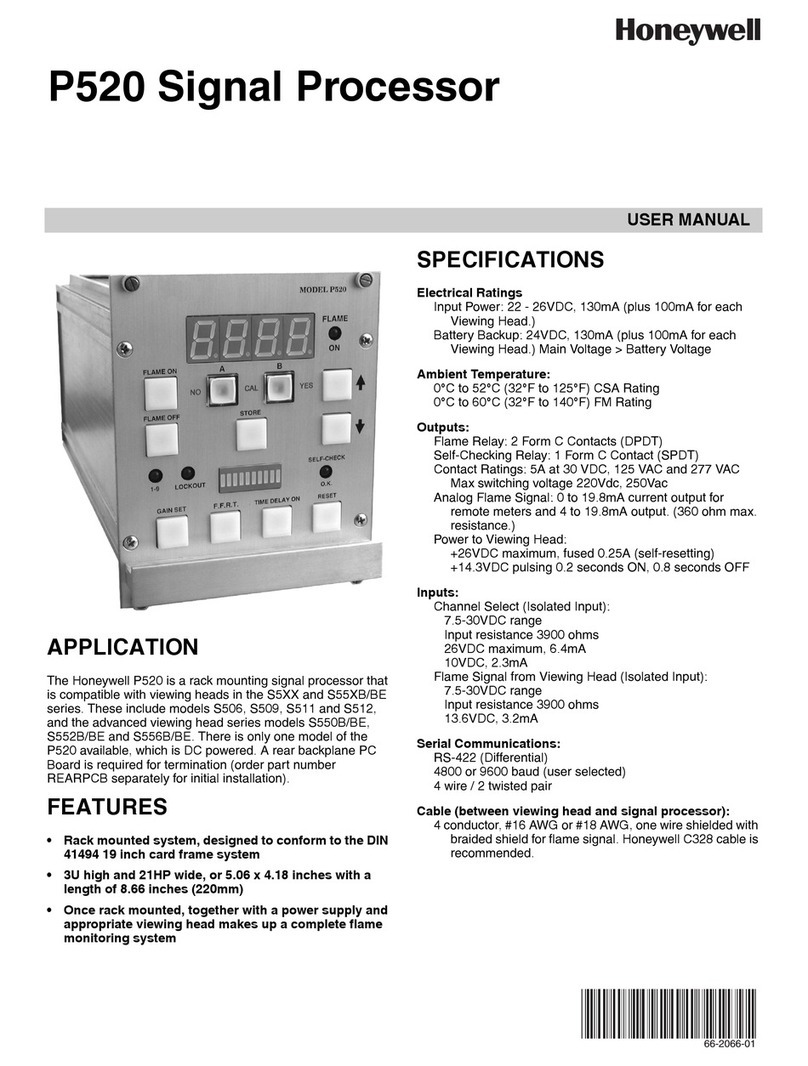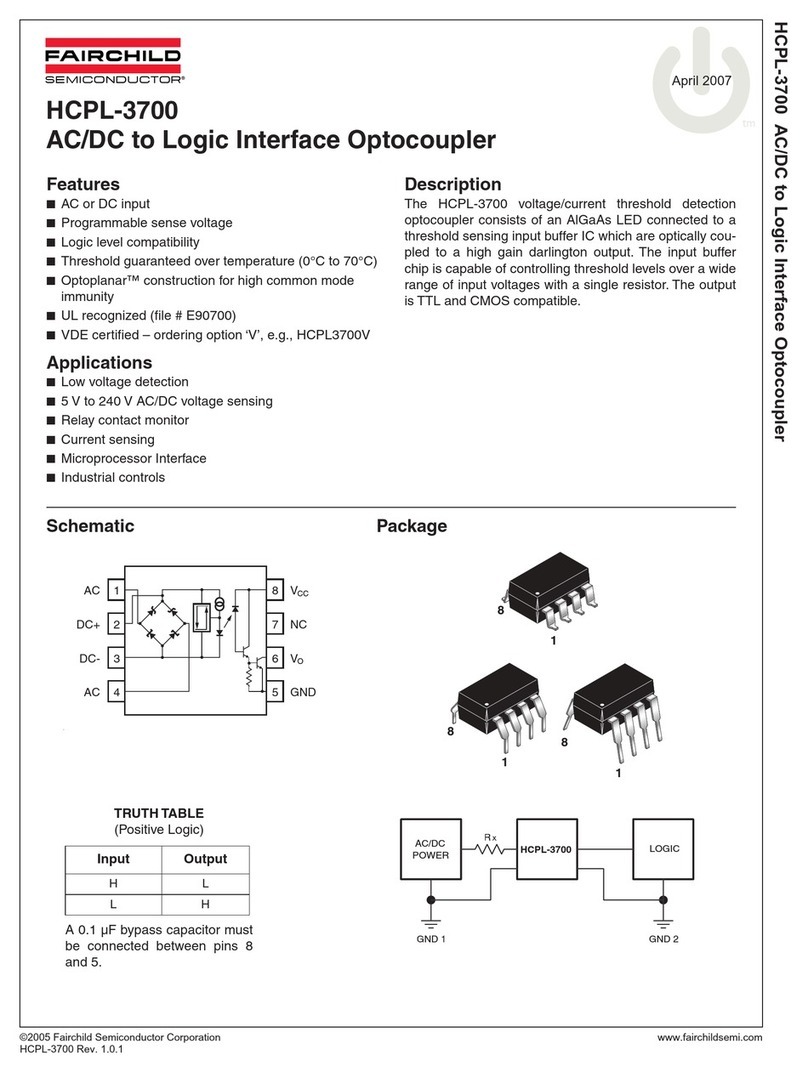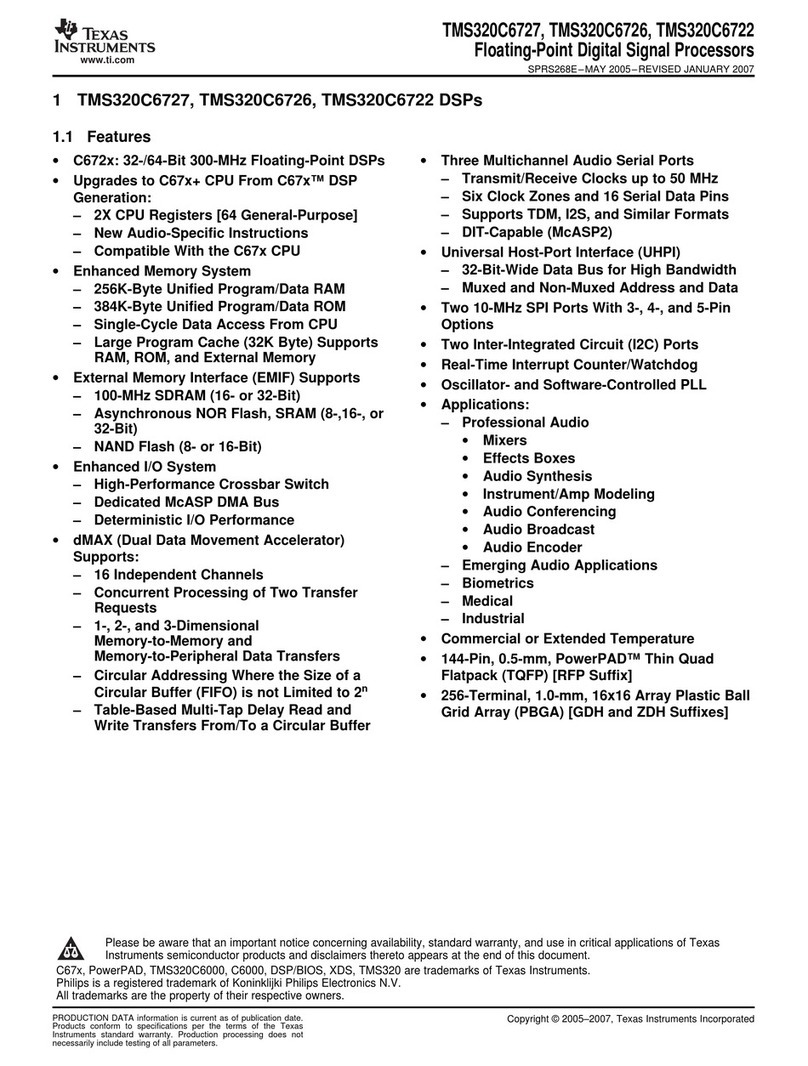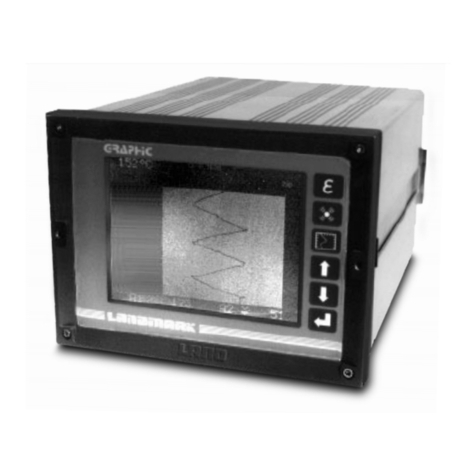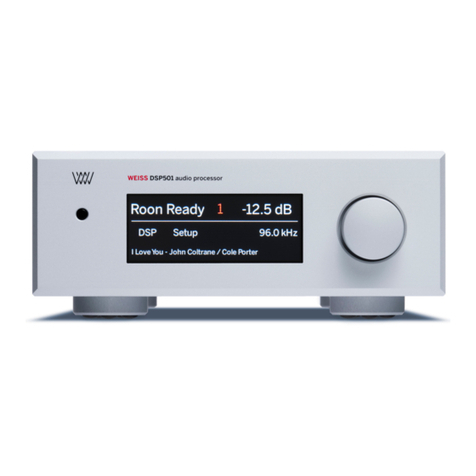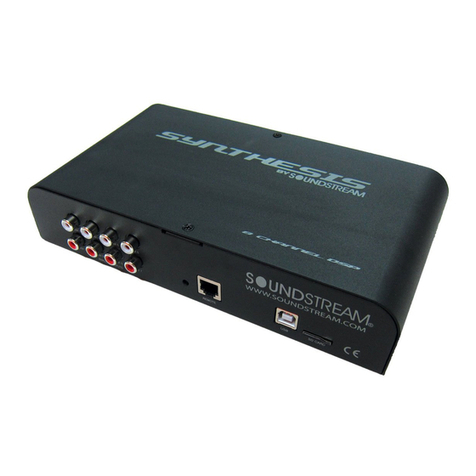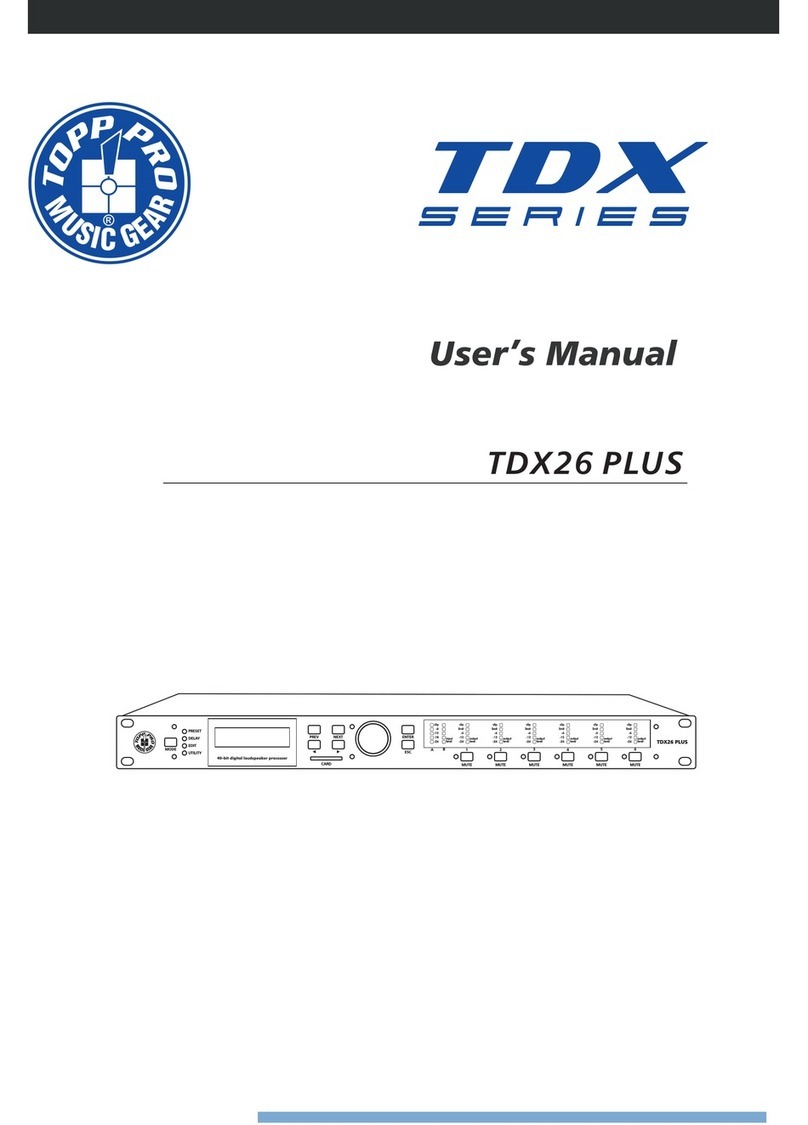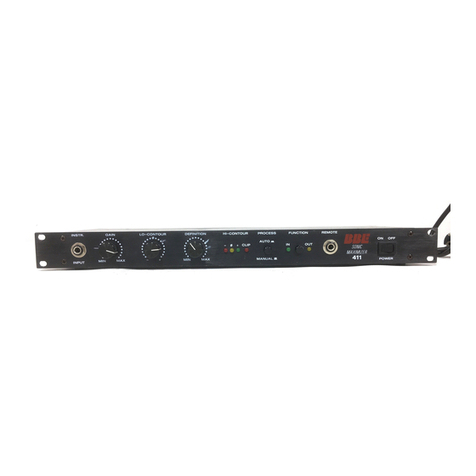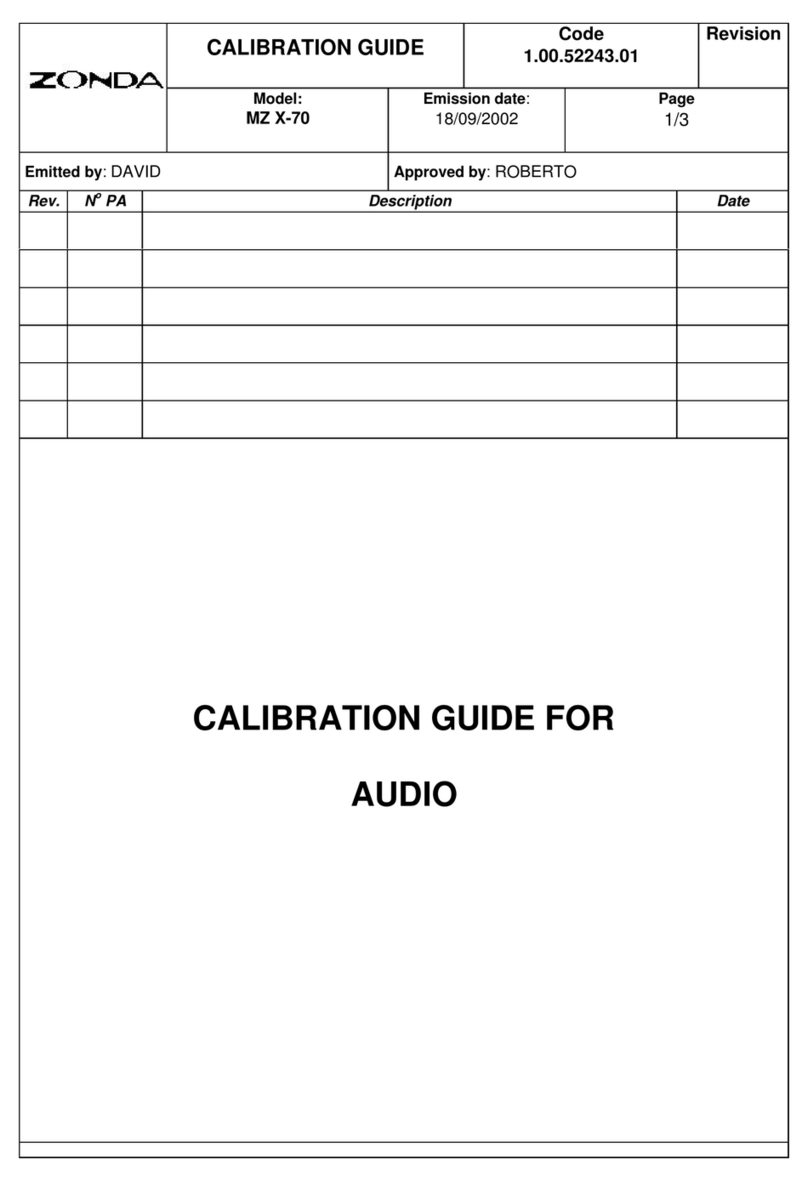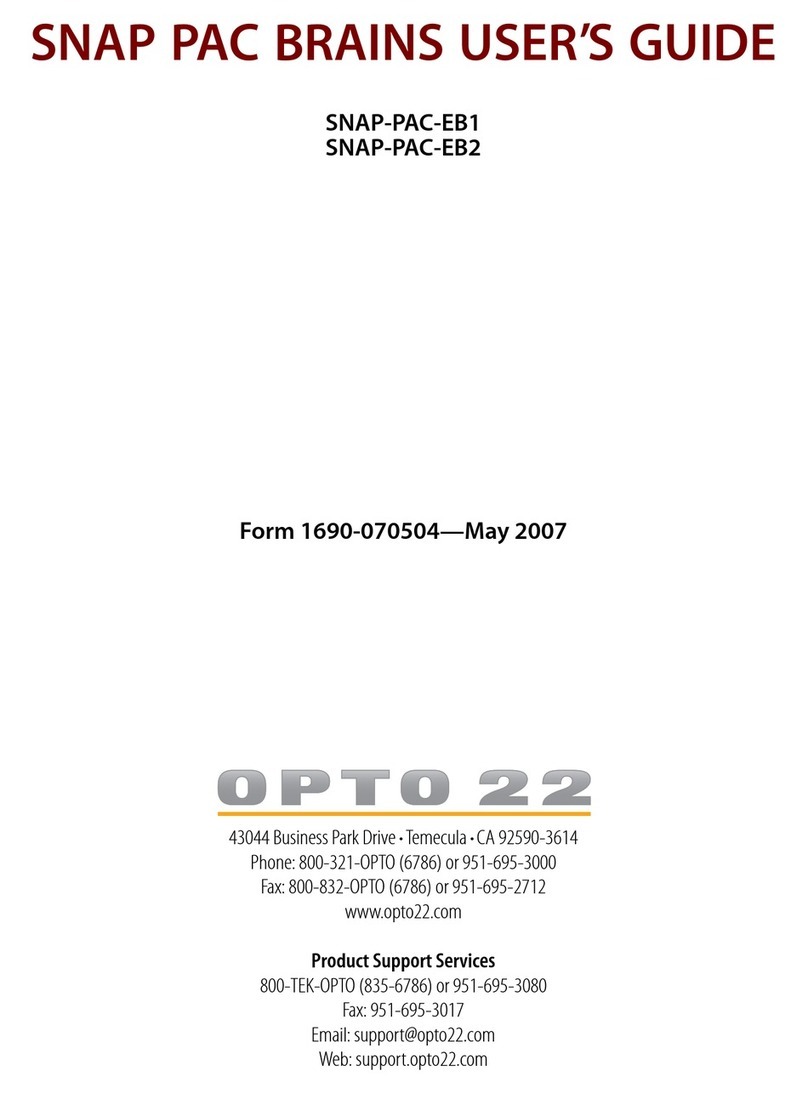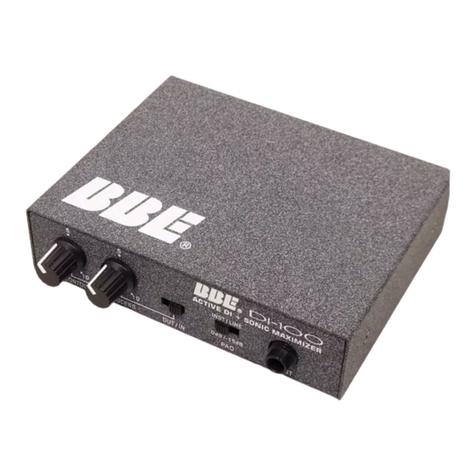SIGNALCORE SC5506A Owner's manual

© 2013-2020 SignalCore, Inc.
support@signalcore.com
SC5506A
25 MHz to 6 GHz RF Signal Source
USB, SPI and RS-232 Interfaces
Operating & Programming Manual

SC5506A Operating & Programming Manual Rev 2.1.1 i
CO N T E N T S
Important Information........................................................................................1
Warranty.................................................................................................................................................1
Copyright & Trademarks ........................................................................................................................2
International Materials Declarations .....................................................................................................2
CE European Union EMC & Safety Compliance Declaration ..................................................................2
Recycling Information.............................................................................................................................3
Warnings Regarding Use of SignalCore Products...................................................................................3
Getting Started ...................................................................................................4
Unpacking...............................................................................................................................................4
Verifying the Contents of your Shipment...............................................................................................4
Setting Up and Configuring the SC5506A...............................................................................................4
Power Connection 5
Signal Connections 5
Communication Connections 6
Reset Button 6
Indicator LEDs 7
SC5506A Theory of Operation.............................................................................8
Output Amplitude Control......................................................................................................................8
Frequency Synthesizer ...........................................................................................................................9
Reference Clock Control.......................................................................................................................10
Harmonics and Range of Operation.....................................................................................................10
Channel Standby and RF Enable...........................................................................................................10
Default Startup Mode...........................................................................................................................11
SC5506A Programming Interface ......................................................................12
Device Drivers.......................................................................................................................................12
Using the Application Programming Interface (API) ............................................................................12
SPI and RS-232 Programming...............................................................................................................12
Setting the SC5506A: Writing to Configuration Registers ..................................13

SC5506A Operating & Programming Manual Rev 2.1.1 ii
Configuration Registers........................................................................................................................13
Initializing the Device ...........................................................................................................................14
Setting the System Active LED..............................................................................................................14
Setting the RF Frequency .....................................................................................................................14
Setting the RF Power............................................................................................................................14
Setting RF Output Enable .....................................................................................................................14
Disabling the Auto Power Feature .......................................................................................................14
Setting the RF Automatic Level Control (ALC) Mode ...........................................................................14
Setting the Device Standby Mode........................................................................................................15
Setting the Reference Clock .................................................................................................................15
Writing to the User EEPROM................................................................................................................15
Setting the Reference DAC Value.........................................................................................................15
Storing the Startup State......................................................................................................................15
Setting the RF ALC DAC Value ..............................................................................................................15
Querying the SC5506A: Writing to Request Registers........................................16
Reading the Device Temperature.........................................................................................................16
Reading the Device Status....................................................................................................................17
Reading the User EEPROM ...................................................................................................................17
Reading the Calibration EEPROM.........................................................................................................18
Reading the RF ALC DAC Value.............................................................................................................18
Reading the Device Parameters (firmware >= rev 4.0 ) .......................................................................18
Calibration EEPROM Map .................................................................................19
Software API Library Functions .........................................................................20
Constants Definitions ...........................................................................................................................21
Type Definitions....................................................................................................................................22
Function Definitions and Usage ...........................................................................................................22
Programming the Serial Peripheral Interface (SPI) ............................................30
The SPI Architecture.............................................................................................................................30
Additional SPI Registers........................................................................................................................31
Writing the SPI Bus...............................................................................................................................31
Reading the SPI Bus..............................................................................................................................32

SC5506A Operating & Programming Manual Rev 2.1.1 iii
Programming the RS-232 Interface ...................................................................33
Writing to the Device via RS-232..........................................................................................................33
Reading from the Device via RS-232 ....................................................................................................33
Using the LabVIEW Functions and NI-VISA...........................................................................................34
Calibration & Maintenance...............................................................................35
Revision Notes..................................................................................................36

SC5506A Operating & Programming Manual Rev 2.1.1 1
IM P O R T A N T IN F O R M A T I O N
Warranty
This product is warranted against defects in materials and workmanship for a period of three years from
the date of shipment. SignalCore will, at its option, repair or replace equipment that proves to be defective
during the warranty period. This warranty includes parts and labor.
Before any equipment will be accepted for warranty repair or replacement, a Return Material
Authorization (RMA) number must be obtained from a SignalCore customer service representative and
clearly marked on the outside of the return package. SignalCore will pay all shipping costs relating to
warranty repair or replacement.
SignalCore strives to make the information in this document as accurate as possible. The document has
been carefully reviewed for technical and typographic accuracy. In the event that technical or
typographical errors exist, SignalCore reserves the right to make changes to subsequent editions of this
document without prior notice to possessors of this edition. Please contact SignalCore if errors are
suspected. In no event shall SignalCore be liable for any damages arising out of or related to this document
or the information contained in it.
EXCEPT AS SPECIFIED HEREIN, SIGNALCORE, INCORPORATED MAKES NO WARRANTIES, EXPRESS OR
IMPLIED, AND SPECIFICALLY DISCLAIMS ANY WARRANTY OF MERCHANTABILITY OR FITNESS FOR A
PARTICULAR PURPOSE. CUSTOMER’S RIGHT TO RECOVER DAMAGES CAUSED BY FAULT OR NEGLIGENCE
ON THE PART OF SIGNALCORE, INCORPORATED SHALL BE LIMITED TO THE AMOUNT THERETOFORE
PAID BY THE CUSTOMER. SIGNALCORE, INCORPORATED WILL NOT BE LIABLE FOR DAMAGES RESULTING
FROM LOSS OF DATA, PROFITS, USE OF PRODUCTS, OR INCIDENTAL OR CONSEQUENTIAL DAMAGES,
EVEN IF ADVISED OF THE POSSIBILITY THEREOF. This limitation of the liability of SignalCore, Incorporated
will apply regardless of the form of action, whether in contract or tort, including negligence. Any action
against SignalCore, Incorporated must be brought within one year after the cause of action accrues.
SignalCore, Incorporated shall not be liable for any delay in performance due to causes beyond its
reasonable control. The warranty provided herein does not cover damages, defects, malfunctions, or
service failures caused by owner’s failure to follow SignalCore, Incorporated’s installation, operation, or
maintenance instructions; owner’s modification of the product; owner’s abuse, misuse, or negligent acts;
and power failure or surges, fire, flood, accident, actions of third parties, or other events outside
reasonable control.

SC5506A Operating & Programming Manual Rev 2.1.1 2
Copyright & Trademarks
Under the copyright laws, this publication may not be reproduced or transmitted in any form, electronic
or mechanical, including photocopying, recording, storing in an information retrieval system, or
translating, in whole or in part, without the prior written consent of SignalCore, Incorporated.
SignalCore, Incorporated respects the intellectual property rights of others, and we ask those who use our
products to do the same. Our products are protected by copyright and other intellectual property laws.
Use of SignalCore products is restricted to applications that do not infringe on the intellectual property
rights of others.
“SignalCore”, “signalcore.com”, and the phrase “preserving signal integrity” are registered trademarks of
SignalCore, Incorporated. Other product and company names mentioned herein are trademarks or trade
names of their respective companies.
International Materials Declarations
SignalCore, Incorporated uses a fully RoHS compliant manufacturing process for our products. Therefore,
SignalCore hereby declares that its products do not contain restricted materials as defined by European
Union directive 2002/95/EC (EU RoHS) in any amounts higher than limits stated in the directive. This
statement is based on the assumption of reliable information and data provided by our component
suppliers and may not have been independently verified through other means. For products sold into
China, we also comply with the “Administrative Measure on the Control of Pollution Caused by Electronic
Information Products” (China RoHS). In the current stage of this legislation, the content of six hazardous
materials must be explicitly declared. Each of those materials, and the categorical amount present in our
products, are shown below:
組成名稱
Model Name
鉛
Lead
(Pb)
汞
Mercury
(Hg)
镉
Cadmium
(Cd)
六价铬
Hexavalent
Chromium
(Cr(VI))
多溴联苯
Polybrominated
biphenyls
(PBB)
多溴二苯醚
Polybrominated
diphenyl ethers
(PBDE)
SC5506A
✓
✓
✓
✓
✓
✓
A ✓indicates that the hazardous substance contained in all of the homogeneous materials for this
product is below the limit requirement in SJ/T11363-2006. An Xindicates that the particular hazardous
substance contained in at least one of the homogeneous materials used for this product is above the limit
requirement in SJ/T11363-2006.
CE European Union EMC & Safety Compliance Declaration
The European Conformity (CE) marking is affixed to products with input of 50 - 1,000 VAC or 75 - 1,500
VDC and/or for products which may cause or be affected by electromagnetic disturbance. The CE marking
symbolizes conformity of the product with the applicable requirements. CE compliance is a
manufacturer’s self-declaration allowing products to circulate freely within the European Union (EU).

SC5506A Operating & Programming Manual Rev 2.1.1 3
SignalCore products meet the essential requirements of Directives 2014/30/EU (EMC) and 2014/35/EU
(product safety) and comply with the relevant standards. Standards for Measurement, Control and
Laboratory Equipment include EN 61326-1:2013 and EN 55011:2009 for EMC, and EN 61010-1 for product
safety.
Recycling Information
All products sold by SignalCore eventually reach the end of their useful life. SignalCore complies with EU
Directive 2012/19/EU regarding Waste Electrical and Electronic Equipment (WEEE).
Warnings Regarding Use of SignalCore Products
(1)
PRODUCTS FOR SALE BY SIGNALCORE, INCORPORATED ARE NOT DESIGNED WITH COMPONENTS NOR TESTED FOR A LEVEL OF
RELIABILITY SUITABLE FOR USE IN OR IN CONNECTION WITH SURGICAL IMPLANTS OR AS CRITICAL COMPONENTS IN ANY LIFE SUPPORT
SYSTEMS WHOSE FAILURE TO PERFORM CAN REASONABLY BE EXPECTED TO CAUSE SIGNIFICANT INJURY TO A HUMAN.
(2)
IN ANY APPLICATION, INCLUDING THE ABOVE, RELIABILITY OF OPERATION OF THE SOFTWARE PRODUCTS CAN BE IMPAIRED BY
ADVERSE FACTORS, INCLUDING BUT NOT LIMITED TO FLUCTUATIONS IN ELECTRICAL POWER SUPPLY, COMPUTER HARDWARE
MALFUNCTIONS, COMPUTER OPERATING SYSTEM SOFTWARE FITNESS, FITNESS OF COMPILERS AND DEVELOPMENT SOFTWARE USED
TO DEVELOP AN APPLICATION, INSTALLATION ERRORS, SOFTWARE AND HARDWARE COMPATIBILITY PROBLEMS, MALFUNCTIONS OR
FAILURES OF ELECTRONIC MONITORING OR CONTROL DEVICES, TRANSIENT FAILURES OF ELECTRONIC SYSTEMS (HARDWARE AND/OR
SOFTWARE), UNANTICIPATED USES OR MISUSES, OR ERRORS ON THE PART OF THE USER OR APPLICATIONS DESIGNER (ADVERSE
FACTORS SUCH AS THESE ARE HEREAFTER COLLECTIVELY TERMED “SYSTEM FAILURES”). ANY APPLICATION WHERE A SYSTEM FAILURE
WOULD CREATE A RISK OF HARM TO PROPERTY OR PERSONS (INCLUDING THE RISK OF BODILY INJURY AND DEATH) SHOULD NOT BE
SOLELY RELIANT UPON ANY ONE COMPONENT DUE TO THE RISK OF SYSTEM FAILURE. TO AVOID DAMAGE, INJURY, OR DEATH, THE
USER OR APPLICATION DESIGNER MUST TAKE REASONABLY PRUDENT STEPS TO PROTECT AGAINST SYSTEM FAILURES, INCLUDING BUT
NOT LIMITED TO BACK-UP OR SHUT DOWN MECHANISMS. BECAUSE EACH END-USER SYSTEM IS CUSTOMIZED AND DIFFERS FROM
SIGNALCORE' TESTING PLATFORMS, AND BECAUSE A USER OR APPLICATION DESIGNER MAY USE SIGNALCORE PRODUCTS IN
COMBINATION WITH OTHER PRODUCTS IN A MANNER NOT EVALUATED OR CONTEMPLATED BY SIGNALCORE, THE USER OR
APPLICATION DESIGNER IS ULTIMATELY RESPONSIBLE FOR VERIFYING AND VALIDATING THE SUITABILITY OF SIGNALCORE PRODUCTS
WHENEVER SIGNALCORE PRODUCTS ARE INCORPORATED IN A SYSTEM OR APPLICATION, INCLUDING, WITHOUT LIMITATION, THE
APPROPRIATE DESIGN, PROCESS AND SAFETY LEVEL OF SUCH SYSTEM OR APPLICATION.

SC5506A Operating & Programming Manual Rev 2.1.1 4
GE T T I N G ST A R T E D
Unpacking
All SignalCore products ship in antistatic packaging (bags) to prevent damage from electrostatic discharge
(ESD). Under certain conditions, an ESD event can instantly and permanently damage several of the
components found in SignalCore products. Therefore, to avoid damage when handling any SignalCore
hardware, you must take the following precautions:
Remove the product from its packaging and inspect it for loose components or any signs of damage. Notify
SignalCore immediately if the product appears damaged in any way.
Verifying the Contents of your Shipment
Verify that your SC5506A kit contains the following items:
Quantity
Item
1
SC5506A Dual Channel RF Signal Source
1
Software Installation USB Flash Drive (may be combined with other products onto a single drive)
Setting Up and Configuring the SC5506A
The SC5506A is a core module-based RF signal source with all I/O connections and indicators located on
the front face of the module as shown in Figure 1. Each location is discussed in further detail below.
Figure 1. Front view of the SC5506A showing user I/O locations.
!
•Ground yourself using a grounding strap or by touching a grounded metal object.
•Touch the antistatic bag to a grounded metal object before removing the hardware
from its packaging.
•Never touch exposed signal pins. Due to the inherent performance degradation caused
by ESD protection circuits in the RF path, the device has minimal ESD protection
against direct injection of ESD into the RF signal pins.
•When not in use, store all SignalCore products in their original antistatic bags.

SC5506A Operating & Programming Manual Rev 2.1.1 5
Power Connection
Power is provided to the device through a two-position screw terminal block connection as shown in
Figure 1. Proper operation of the device requires +12 VDC source and ground return wires capable of
delivering a minimum current of 1.5 Amps. The polarity of the connector is shown on the front panel of
the RF module, just above the screw terminal block.
Signal Connections
All signal connections (ports) on the SC5506A are SMA-type. Exercise caution when fastening cables to
the signal connections. Over-tightening any connection can cause permanent damage to the device.
The condition of your system‘s signal connections can significantly affect measurement
accuracy and repeatability. Improperly mated connections or dirty, damaged or worn
connectors can degrade measurement performance. Clean out any loose, dry debris from
connectors with clean, low-pressure air (available in spray cans from office supply stores).
If deeper cleaning is necessary, use lint-free swabs and isopropyl alcohol to gently clean inside
the connector barrel and the external threads. Do not mate connectors until the alcohol has
completely evaporated. Excess liquid alcohol trapped inside the connector may take several
days to fully evaporate and may degrade measurement performance until fully evaporated.
Tighten all SMA connections to 5 in-lb max (56 N-cm max).
RF OUT
CHANNEL 1
This port outputs the tunable RF signal from channel 1 of the source. The
connector is SMA female. The nominal output impedance is 50 Ω.
RF OUT
CHANNEL 2
This port outputs the tunable RF signal from channel 2 of the source. The
connector is SMA female. The nominal output impedance is 50 Ω.
REF OUT
This port outputs the internal 10 MHz reference clock. The connector is SMA
female. This port is AC-coupled with a nominal output impedance of 50 Ω.
REF IN
This port accepts an external 10 MHz reference signal, allowing an external
source to synchronize the internal reference clock. The connector is SMA
female. This port is AC-coupled with a nominal input impedance of 50 Ω.
Maximum input power is +13 dBm.
!
!

SC5506A Operating & Programming Manual Rev 2.1.1 6
Communication Connections
The SC5506A uses a mini-USB Type B connector (for USB communication) and a micro-HDMI (for SPI or
RS-232 communication, depending on the version ordered) to communicate with the device. The USB port
uses the standard USB 2.0 protocol found on most host computers. The pinout of this connector, viewed
from the front of the module, is listed in Table 1.
Table 1. Pinout of the SC5506A USB communication connector.
Pin Number
USB Function
Description
1
VBUS
Vcc (+5 Volts)
2
D –
Serial data
3
D +
Serial data
4
ID
Not used
5
GND
Device ground (also tied to connector shell)
The user can also communicate with the device through the micro-HDMI port. Depending on the version
ordered, this connector provides either the SPI or RS-232 communication path. The pinout of this
connector, viewed from the front of the module, is listed in Table 2.
Table 2. Pinout of the SC5506A micro-HDMI connector for either SPI or RS-232 communication.
Pin Number
SPI Function
RS-232 Function
3
MISO
TxD
5
–
–
8
RESET_B
RESET_B
9
MOSI
RxD
11
CS
–
15
SRLDY
–
17
CLK
–
18
SPI MODE
BAUD SELECT
4, 7, 10, 13, 16
GND
GND
1, 2, 8, 12, 14, 19
NC
NC
Reset Button
Depressing this momentary-action push button switch will reset the device to its default state. The
SC5506A has the ability to store the current configuration at any point as the default setting. If the factory
setting has been overwritten with a saved user configuration, resetting the device will reinitialize the

SC5506A Operating & Programming Manual Rev 2.1.1 7
device to the saved user configuration. Otherwise, resetting the device will restore the factory
configuration. Refer to the table in the “Default Startup Mode” section of this manual for default settings.
Indicator LEDs
The SC5506A provides visual indication of important modes. There are three LED indicators on the unit.
Their behavior under different operating conditions is shown in Table 3.
Table 3. LED indicator states.
LED
Color
Definition
STATUS
Green
“Power good” and all oscillators phase-locked
STATUS
Orange
Channel powered down
STATUS
Red
One or more oscillators off lock
STATUS
Off
Power fault
ACTIVE
Green/Off
Device is open (green) /closed (off) , this indicator is also
user programmable (see register map)

SC5506A Operating & Programming Manual Rev 2.1.1 8
SC5 5 0 6 A TH E O R Y O F OP E R A T I O N
Output Amplitude Control
As shown in Figure 2, the SC5506A source architecture at a high level consists of an output amplitude
control section and a frequency synthesis section. The amplitude of the signal is controlled through the
use of digital step attenuators (DSAs) and a voltage controlled attenuator (VCA). The DSAs provide the
coarse-step tuning over a wide range while the VCA provides fine tune correction to the DSAs. The VCA is
part of the automatic level control loop (ALC), which additionally consists of an RF amplifier, a power
detector, and an integrator. The ALC loop can be closed or open. In the closed loop mode, the power
detector outputs a voltage proportional to the power it detects. This voltage is compared to that of the
reference ALC DAC voltage, which in turn is set for some calibrated power level. Voltage error between
the detector voltage and the ALC DAC voltage drives the integrator output in the direction that will vary
the VCA to achieve the desired output power level. When the ALC control loop is opened, the power
detector output voltage is grounded, and the integrator is configured as a voltage buffer that drives the
ALC DAC voltage to the VCA. In this mode, the ALC DAC voltage directly drives the VCA with voltage levels
that correspond to calibrated output power levels.
There are advantages and disadvantages to either of these two amplitude control modes. On one hand,
the open loop mode has an advantage over the closed loop mode when close-in carrier amplitude noise
is a concern. ALC loops do introduce some level of amplitude modulated noise onto the carrier signal, and
these levels may not be acceptable (although they are generally lower than the phase noise). SignalCore
offers the user the option to open the ALC loop to remove any unwanted AM noise that results from
closed loop control. Another side effect of the closed loop is that the frequency bandwidth of the ALC loop
may slow down amplitude settling. Typically, in order to keep AM noise low and close (in offset frequency)
to the signal, the loop bandwidth is also kept low. As a result, the settling time is increased.
On the other hand, a closed loop ALC provides better amplitude control over the entire frequency range.
With a temperature-stable ALC DAC, the closed loop will precisely maintain the power at the detector,
mitigating errors in the components prior to it in the signal path. Temperature-induced errors in
components and abrupt amplitude changes when switching filters in the filter banks contribute to errors
in the amplitude of the signal. However, these errors occur before the power detector and are
compensated by the feedback loop action. Errors in amplitude are thus confined to the output
attenuators, amplifiers, and the loop components. When the loop is opened, amplitude errors resulting
from all parts of the amplitude control section as well as the synthesizer section will affect the overall
output amplitude accuracy. In particular, when the filters within the filter bank are switched from one to
another, the signal experiences abrupt discontinuities in its amplitude which the open loop calibration
cannot appropriately account for in its correction algorithm.
Setting of the amplitude control components are performed automatically by the system, although the
user may choose to override the ALC DAC value if needed. In Figure 2, the labels in red indicate parameters
or devices which the user has direct control over.

SC5506A Operating & Programming Manual Rev 2.1.1 9
Frequency Synthesizer
The synthesizer section of the SC5506A comprises a multiple phase-locked loop architecture whose base
frequency reference is a 10 MHz TCXO. The user may choose to phase-lock this base reference to an
external source if required. The 100 MHz VCXO is phase-locked to the TCXO for frequency stability. While
the TCXO determines the very close-in phase noise, the VCXO phase noise determines the system phase
noise in the frequency offset range of approximately 1 kHz to 30 kHz. The 100 MHz VCXO provides the
reference signal to the main RF signal synthesizer, which is comprised of three phase-locked loops (PLLs)
and a direct digital synthesis (DDS) oscillator. The “fine” PLL provides a tuning resolution of few millihertz
over a narrow frequency range, while the “coarse” PLL tunes in steps of a few megahertz over several
gigahertz of range. The “main” or summing PLL combines the signals of the “coarse” and “fine” loops into
one broad tuning signal with fine tuning capability.
Figure 2. Simplified block diagram of the SC5506A dual channel RF signal source.
Using this multiple loop approach produces signals with low phase noise and low phase spurs, high levels
of which exist in single loop architectures such as single fractional-N PLLs. Although a single fractional-N
type PLL may provide fine resolution, its large fractional spurs may make it unusable in certain parts of
the band - especially at frequency regions close the integer boundaries. A multiple loop architecture
allows fine tuning with extremely low phase spurs.
N
N
N
N
N
N
N
N
A
M
CH2
CH1
REF
OUT
REF
IN
REF
DAC
ALC
DAC
ALC
MODE
ALC
DAC
ALC
MODE
10 MHz
TCXO
100
MHz
VCXO
DDS
DDS
COARSE
PLL
FINE PLL
MAIN PLL
FINE PLL
MAIN PLL
COARSE
PLL
ALC LOOP
ALC LOOP
FILTER
BANK
FILTER
BANK
3-6 GHz
3-6 GHz
1,2,4,..128
1,2,4,..128
VCA
VCA
REF
OUT
ENABLE
LCK
EXT
REF
0-60 dB
DSA
0-60 dB
DSA

SC5506A Operating & Programming Manual Rev 2.1.1 10
Reference Clock Control
As mentioned above, the primary clock reference for the SC5506A is an onboard 10 MHz TCXO. Should
the user require better frequency stability and/or accuracy, this TCXO can be programmed to phase-lock
to an external source such as an OCXO or rubidium clock. The device can also be programmed to export
its internal 10 MHz clock. To adjust the accuracy of the TCXO as needed (e.g., to correct for long-term
accuracy drift), the user may vary the reference DAC voltage by writing the REFERENCE_DAC_SETTING
register.
Harmonics and Range of Operation
The SC5506A’s guaranteed operating frequency range is 100 MHz to 6.0 GHz. However, the device is
capable of tuning as low as 25 MHz and as high as 6.15 GHz. Within these out-of-range regions, the
amplitude may not be within specification but the frequency accuracy will not be affected. At low
frequencies of operation (200 MHz and lower), the harmonics of the signal can potentially be observed as
high as -10 dBc at 0 dBm output. This is due to the limited space available for additional filtering in these
ranges. At lower frequencies, the large physical size of appropriate filters makes it impossible to
accommodate them within the compact form of this device. Furthermore, as the low frequencies are
synthesized through frequency dividers, their output waveforms become more “square” than sinusoidal,
giving rise to higher odd-order harmonics.
The device is specified to a maximum calibrated level of +10 dBm, although the maximum calibrated
output is greater than that in most regions of the spectrum. The accuracy degrades as the amplitude
approaches the compression point due to the linear approximation in the correction algorithm. As a
general rule however, the lower the tuned frequency the higher the achievable output power.
Channel Standby and RF Enable
The SC5506A has independent standby and output enable features for both channels. The user may wish
to place one or both of the channels into standby mode to reduce power consumption and thus lower the
operating temperature of the device under the same environmental conditions. Putting one channel into
standby also eliminates its signal generation, and as a result the remaining operational channel does not
receive any cross-signal contamination, especially when generating low level signals. Although the device
has the option to independently disable the RF output of one channel or the other, this feature does not
shut down the internal synthesizer, so there still exists the possibility of contaminating signals. They are
usually very low but might not be tolerated in some applications. Taking either channel out of standby
requires the device to wait for the power rails to settle and all internal components to be reprogrammed,
usually on the order of one second.
Disabling the RF output moves the frequency to some very low value so that the step attenuators and the
voltage controlled attenuator have the most effective attenuation. Combined, this will push the signal
level below -100 dBm. Enabling the RF output is nearly instantaneous as all components remain active
even when the RF output is disabled.

SC5506A Operating & Programming Manual Rev 2.1.1 11
Default Startup Mode
The factory power-up state for the device is detailed in Table 4. The default state can be changed to the
current state of either channel programmatically, allowing the user to power up the device in the last
saved state without having to reprogram.
Table 4. Factory default power-up state.
CH1
CH2
Frequency
2.0 GHz
2.4 GHz
Power
0.00 dBm
0.00 dBm
RF Output
Enabled
Enabled
ALC Mode
Closed Loop
Closed Loop
Standby
Disabled
Disabled
Auto Level
Enabled
Enabled
Ref Out
Disabled
Ext Ref Lock
Disabled

SC5506A Operating & Programming Manual Rev 2.1.1 12
SC5 5 0 6 A PR O G R A M M I N G IN T E R F A C E
Device Drivers
The SC5506A is programmed by writing to its set of configuration registers, and its status read back
through its set of query registers. The user may choose to program directly at register level or through the
API library functions provided. These API library functions are wrapper functions of the registers that
simplify the task of configuring of the register bytes. The register specifics are covered in the next section.
Writing to and reading from the device at the register level through the API involves calls to the
sc5506a_RegWrite and sc5506a_RegRead functions respectively.
For Microsoft WindowsTM operating systems, The SC5506A API is provided as a dynamic linked library,
sc5506a.dll, which is available for 32bit and 64bit operating systems. This API is based on the libusb-1.0
library and therefore it is required to be installed on the system prior to development. The libusb-1.0.dll
will install along with the sc5506a.dll, and along with the header files for development. However for
possible newer versions of libusb-1.0, visit http://libusbx.org to check for version updates and downloads.
To install the necessary drivers, right click on the sc5506a.inf file in the Win\directory and choose install.
When the device is connected to a USB port, the host computer should identify the device and load the
appropriate driver. For more information, see the SC5506A_Readme.txt file in the Win\ directory.
For LabVIEWTM support, a full LabVIEW API is provided and is available in the Win\API\LabVIEW\ directory.
To use the library, copy the “SignalCore” folder in that directory to %LabVIEW path%\instr.lib location of
your LabVIEW installation directory. The LabVIEW functions are simply VI wrappers around sc5506a.dll.
Code written purely in G that does not call or depend on external library functions is available to our
customers on request. If pure G code SC5506A API functions are implemented, the National Instruments
driver wizard packaged with NI-VISA should be used to create a driver for the intended operating system.
SignalCore's vendor ID is 0x277C and the product ID (PID) is 0x0016.
For other operating systems, users will need to write and compile their own drivers. The device register
map provides the necessary information to successfully implement a driver for the SC5506A. Driver code
based on libusb-1.0 is available to our customers on request. Should the user require assistance in writing
an appropriate API other than that provided, please contact SignalCore for additional example code and
hardware details.
Using the Application Programming Interface (API)
The SC5506A API library functions make it easy for the user to communicate with the device. Using the
API removes the need to understand register-level details - their configuration, address, data format, etc.
Using the API, commands to control the device are greatly simplified. For example, to obtain the device
temperature, the user simply calls the function sc5506A_GetDeviceTemperature, or calls
sc5506A_SetFrequency to tune the frequency. The software API is covered in detail in the “Software API
Library Functions” section.
SPI and RS-232 Programming
Please see the SPI and RS-232 sections of this manual for interfacing to the device registers using either
of these communication methods.

SC5506A Operating & Programming Manual Rev 2.1.1 13
SE T T I N G T H E SC5 5 0 6 A: WR I T I N G T O
CO N F I G U R A T I O N RE G I S T E R S
Configuration Registers
The users may write the configuration registers (write only) directly by calling the sc5506a_RegWrite
function. The syntax for this function is sc5506a_RegWrite(deviceHandle, registerCommand,
instructWord). The instructWord takes a 64 bit-word. However, it will only send the required number of
bytes to the device. These registers are the same for USB, SPI, and RS-232. Table 5 summarizes the register
addresses (commands) and the effective bytes of command data.
Table 5. Configuration registers.
Register Name
Register
Address
Serial
Range
Bit 7
Bit 6
Bit 5
Bit 4
Bit 3
Bit 2
Bit 1
Bit 0
INITIALIZE
0x01
[7:0]
Open
Open
Open
Open
Open
Open
Open
Mode
SET_SYSTEM_ACTIVE
0x02
[7:0]
Open
Open
Open
Open
Open
Open
Open
Enable
“active”
LED
RF_FREQUENCY
0x10
[7:0]
Frequency Word (MHz) [7:0]
[15:8]
Frequency Word (MHz) [15:8]
[23:16]
Frequency Word (MHz) [23:16]
[31:24]
Frequency Word (MHz) [31:24]
[39:32]
Frequency Word (MHz) [39:32]
[47:40]
Open
Open
Open
Open
Open
Open
Open
Channel
RF_POWER
0x11
[7:0]
RF Power Word [7:0]
[15:8]
Sign Bit
RF Power Word [14:8]
[23:9]
Channel
RF_OUT_ENABLE
0x12
[7:0]
Open
Open
Open
Open
Open
Open
Channel
Mode
AUTO_POWER_DISABLE
0x13
[7:0]
Open
Open
Open
Open
Open
Open
Channel
Mode
RF_ALC_MODE
0x14
[7:0]
Open
Open
Open
Open
Open
Open
Channel
Mode
DEVICE_STANDBY
0x15
[7:0]
Open
Open
Open
Open
Open
Open
Channel
Mode
REFERENCE_MODE
0x16
[7:0]
Open
Open
Open
Open
Open
Open
Ref Out
Enable
Lock
Enable
USER_EEPROM_WRITE
0x1B
[7:0]
Data [7:0]
[15:8]
EEPROM Address [7:0]
[23:16]
EEPROM Address [15:8]
REFERENCE_DAC_SETTING
0x1D
[7:0]
DAC word [7:0]
[15:8]
Open
Open
DAC word [13:8]
STORE_STARTUP_STATE
0x23
[7:0]
Open
Open
Open
Open
Open
Open
Open
Open
SET_ALC_DAC_VALUE
0x24
[7:0]
ALC DAC Word [7:0]
[15:8]
ALC DAC Word [13:8]
[23:16]
Open
Open
Open
Open
Open
Open
Open
Channel

SC5506A Operating & Programming Manual Rev 2.1.1 14
To write to the device through USB transfers such as bulk transfer, it is important to send data with the
register byte first, followed by the most significant bit (MSB) of the data bytes. For example, to set the
RF power level of channel 2 to a particular amplitude, the byte stream would be [0x11][0x01][15:8][7:0].
Initializing the Device
INITIALIZE (0x01) - Writing 0x00 to this register will reset the device to the default power-on state. Writing
0x01 will reset the device but leave it in the current state. The user has the ability to define the default
startup state by writing to the STORE STARTUP STATE (0x23) register, described later in this section.
Setting the System Active LED
SET_SYSTEM_ACTIVE (0x02) - This register simply turns on the front panel “active” LED with a write of
0x01 or turns off the LED with a write of 0x00. This register is generally written when the device driver
opens or closes the device.
Setting the RF Frequency
RF_FREQUENCY (0x10) - This register set the RF frequency for each channel. Data is sent as a 40 bit word
with the LSB in Hz.
Setting the RF Power
RF_POWER (0x11) - This register sets the RF power level for each channel. The LSB is 1/100th of a dB and
absolute magnitude is carried in the first 15 bits, starting with bit 0. The sign bit is indicated on bit 15.
Setting bit 15 high implies a negative magnitude. For example, to write 10.05 dBm to the register, the data
is simply 1005 (0x03ED). For -10.05 dBm, the data is 33773 (0x83ED).
Setting RF Output Enable
RF_OUT_ENABLE (0x12) - This register enables or disables the RF signal output for each channel. Setting
bit 0 low (0) disables RF output. Setting bit 0 high (1) enables RF output.
Disabling the Auto Power Feature
AUTO_POWER_DISABLE (0x13)–When changing frequency on either channel, the device will calculate
new settings for the amplitude control components such that the amplitude remains the same as the last
setting. If the amplitude is also changed at the new frequency setting, the user has the option to turn off
this auto power adjustment. By default, auto power adjustment is enabled. To disable auto power
adjustment, set bit 0 of this register high (1).
Setting the RF Automatic Level Control (ALC) Mode
RF_ALC_MODE (0x14) –For each channel independently, writing 0x00 to this register puts the ALC in a
closed loop operation. Writing 0x01 will run the ALC in an open loop. See the “Output Amplitude Control”
section to understand the differences between the modes.

SC5506A Operating & Programming Manual Rev 2.1.1 15
Setting the Device Standby Mode
DEVICE_STANDBY (0x15) –For each channel, writing 0x01 to this register will power-down the analog/RF
circuitry. Writing 0x00 to this register will enable the analog/RF circuitry and the channel will return to its
last programmed state.
Setting the Reference Clock
REFERENCE_MODE (0x16) - This register sets the behavior of the reference clock section. Bit 1 enables (1)
or disables (0) the output reference signal, and Bit 0 enables (1) or disables (0) the device to phase-lock
to an external source. It is important that if the device is not intended to lock externally, the external
source connection should be removed from the “ref in” connector. Even with external locking disabled,
the presence of a large signal from the external source on the reference input terminal could potentially
modulate the internal references, causing a spur offset in the RF signal.
Writing to the User EEPROM
USER_EEPROM_WRITE (0x1B) - There is an onboard 32 kilobyte EEPROM for the user to store data. User
data is sent one byte at a time and is contained in the last (least significant) byte of the three bytes of data
written to the register. The other two bytes contain the write address in the EEPROM. For example, to
write user data 0x22 into address 0x1F00 requires writing 0x1F0022 to this register.
Setting the Reference DAC Value
REFERENCE_DAC_SETTING (0x1D) - The frequency precision of the device’s 10 MHz TCXO is set by the
device internally and the factory calibrated unsigned 14 bit value is written to the reference DAC on
power-up from the EEPROM. The user may choose to write a different value to the reference DAC by
accessing this register for example, to correct for long-term accuracy drift.
Storing the Startup State
STORE_STARTUP_STATE (0x23) –Writing to this register will save the current device state as the new
default power on (startup) state. All data written to this register will be ignored as only the write command
is needed to initiate the save.
Setting the RF ALC DAC Value
SET_ALC_DAC_VALUE (0x24) - Writing a 14 bit control word to the ALC DAC register adjusts output
amplitude. This is useful when the user wants to make minute adjustments to the power level.

SC5506A Operating & Programming Manual Rev 2.1.1 16
QU E R Y I N G T H E SC5 5 0 6 A: WR I T I N G T O
RE Q U E S T RE G I S T E R S
The registers to read data back from the device (such as device status) are accessed through the
sc5506a_RegRead function. The function and parameter format for this command is
sc5506a_RegRead(deviceHandle, registerCommand, instructWord,*dataOut). Any instructions in
addition to the register call is placed into “instructWord”, and data obtained from the device is returned
via the pointer value dataOut. The set of request registers are shown in Table 6.
Table 6. Query registers.
Register Name
Register
Address
Serial Range
Bit 7
Bit 6
Bit 5
Bit 4
Bit 3
Bit 2
Bit 1
Bit 0
GET_TEMPERATURE
0x17
[7:0]
Open
Open
Open
Open
Open
Open
Open
Open
GET_DEVICE_STATUS
0x18
[7:0]
Open
Open
Open
Open
Open
Open
Open
Open
USER_EEPROM_READ
0x1A
[7:0]
EEPROM Address [7:0]
[15:8]
EEPROM Address [15:8]
CAL_EEPROM_READ
0x21
[7:0]
EEPROM Address [7:0]
[15:8]
EEPROM Address [15:8]
GET_ALC_DAC_VALUE
0x39
[7:0]
Open
Open
Open
Open
Open
Open
Open
Channel
GET_DEVICE_PARAMS
0x25
[7:0]
Open
Open
Open
Open
Parameter value
To read from the device using native USB transfers instead of the sc5506a_RegRead function requires two
operations. First, a write transfer is made to the device ENPOINT_OUT to tell the device what data needs
to be read back. Then, a read transfer is made from ENDPOINT_IN to obtain the data. The number of valid
bytes returned varies from 1 to 3 bytes. See the register details below.
Reading the Device Temperature
GET_TEMPERATURE (0x17) - Data returned by this register needs to be processed to correctly represent
data in temperature units of degrees Celsius. Data is returned in the first 14 bits [13:0]. Bit [13] is the
polarity bit indicating whether it is positive (0x0) or negative (0x1). For an ENDPOINT_IN transfer, data is
returned in 2 bytes with the MSB first. The temperature value represented in the raw data is contained in
the next 13 bits [12:0]. To obtain the temperature ADC code, the raw data should be masked (bitwise
AND’ed) with 0x1FFF, and the polarity should be masked with 0x2000. The conversion from 12 bit ADC
code to an actual temperature reading in degrees Celsius is shown below:
Positive Temperature (bit 13 is 0)
=
ADC code / 32
Negative Temperature (bit 13 is 1)
=
(ADC code –8192) / 32
It is not recommended to read the temperature too frequently, especially once the SC5506A has stabilized
in temperature. The temperature sensor is a serial device located inside the RF module. Therefore, like
any other serial device, reading the temperature sensor requires sending serial clock and data commands
from the processor. The process of sending clock pulses on the serial transfer line may cause unwanted
This manual suits for next models
2
Table of contents
Other SIGNALCORE Signal Processor manuals
